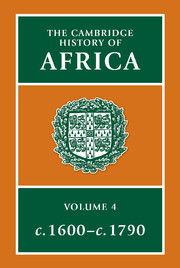Book contents
- Frontmatter
- Introduction
- 1 Egypt, the Funj and Darfur
- 2 The central Sahara and Sudan
- 3 North-West Africa: from the Maghrib to the fringes of the forest
- 4 The Guinea coast
- 5 Central Africa from Cameroun to the Zambezi
- 6 Southern Africa and Madagascar
- 7 Eastern Africa
- 8 Ethiopia and the Horn of Africa
- 9 Africa in Europe and the Americas
- Bibliographical Essays
- Bibliography
- Index
- References
1 - Egypt, the Funj and Darfur
Published online by Cambridge University Press: 28 March 2008
- Frontmatter
- Introduction
- 1 Egypt, the Funj and Darfur
- 2 The central Sahara and Sudan
- 3 North-West Africa: from the Maghrib to the fringes of the forest
- 4 The Guinea coast
- 5 Central Africa from Cameroun to the Zambezi
- 6 Southern Africa and Madagascar
- 7 Eastern Africa
- 8 Ethiopia and the Horn of Africa
- 9 Africa in Europe and the Americas
- Bibliographical Essays
- Bibliography
- Index
- References
Summary
OTTOMAN EGYPT
Egypt, although geographically situated in Africa, was at the beginning of the sixteenth century essentially a part of the Near East by virtue of its recent history, its culture and its closest political connections. One of the earliest of Muslim conquests, Egypt had grown in importance as a centre of Islam when, in the thirteenth century, its rulers halted the Mongol advance which had overwhelmed the eastern Islamic territories and extinguished the caliphate in Baghdad. The same episode had confirmed the links between Egypt and Syria, and the Mamluk sultans succeeded the Ayyubids and the Fatimid caliphs as the rulers of an empire situated at the crossroads of western Asia and northern Africa. With the Maghrib, the upper valley of the Nile, and the trans Saharan Sudan, there were trading connections, while Muslims came from these regions to study at the university mosque al-Azhar or to travel as pilgrims to the holy cities of the Hejaz. But the political bond between Egypt and the adjacent parts of North Africa, which had briefly existed under the Fatimids, was never renewed, while not until the nineteenth century did a ruler of Egypt effectively govern the Nile beyond Aswan. The Ottoman conquest, which ended the Mamluk sultanate, and converted Egypt into an outlying province of an empire with its centre at Istanbul, continued the historic detachment of the country from Africa and its association with the Islamic Near East.
- Type
- Chapter
- Information
- The Cambridge History of Africa , pp. 14 - 57Publisher: Cambridge University PressPrint publication year: 1975



